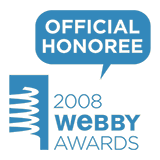Emdashes—Modern Times Between the Lines
The Basics:
About Emdashes | Email us
Ask the Librarians
Best of Emdashes: Hit Parade
A Web Comic: The Wavy Rule
Features & Columns:
Headline Shooter
On the Spot
Looked Into
Sempé Fi: Cover Art
The Way We Live Now
Filed under: Personal Tagged: clips, copywriting, criticism, Emily Gordon, journalism, New Yorker, poet, poetry, portfolio, Print magazine, reviews
Here’s a long-winded description of me if you’re here for the first time: I’m a writer, editor, and digital strategist; my keenest interests are books and culture, politics and social issues, technology and design. I was a staff theater critic for Time Out Chicago; here are those reviews. As a book critic and feature writer, I’ve interviewed Edward Gorey, Aisha Tyler, J. K. Rowling, Lewis Lapham, Ayaan Hirsi Ali, Nick Hornby, Cathleen Schine, Françoise Mouly, Paul Auster, and gifted young designers, among many others. (continued)
Interview: Frankie Manning, Lindy Hop Legend (Newsday)
Filed under: Personal Tagged: clips, dance, Frankie Manning, interviews, lindy hop, Marx Brothers, swing, Whitey's Lindy Hoppers
He Put the Hop in the Lindy | Frankie Manning, the Last King of Swing
By Emily Gordon and Robert L. Fouch
Imagine this scene: In a packed ballroom, hundreds of women edge closer to the dance floor, angling for a chance with that handsome fellow with the brilliant smile, the one who moves with such power and grace. Never mind that the man is 85 years old. This is the legend of lindy, the king of Harlem’s Savoy Ballroom in its heyday, who danced for royalty and has sidestepped old age as he would another couple on the floor. This is Frankie Manning, and as the song begins to swing, the women clamor to be one of his 85 partners—one for each of Manning’s remarkable years.
(continued)Writing About Poetry
Filed under: Personal Tagged: books, clips, in memoriam, Newsday, poetry, The Nation
Reviews:
Poetry Without Pain: National Poetry Month roundup (Newsday)
How to Read a Poem: And Fall in Love With Poetry, by Edward Hirsch
How to Read a Poem…And Start a Poetry Circle, by Molly Peacock
A Grain of Poetry: How to Read Contemporary Poems and Make Them Part of Your Life, by Herbert Kohl
Poetry Anthologies After September 11 (Newsday)
Poetry After 9/11: An Anthology of New York Poets, ed. Dennis Loy Johnson and Valerie Merians
110 Stories: New York Writes After September 11, ed. Ulrich Baer
Poems of New York, ed. Elizabeth Schmidt
Speaking From Memory (Newsday)
Handwriting: Poems, by Michael Ondaatje
Above an Abyss (The Nation)
Meadowlands, by Louise Glück
Otherwise: New and Selected Poems, by Jane Kenyon
Pollitt, Poet (The Nation)
The Mind-Body Problem: Poems, by Katha Pollitt
Obituaries:
Ted Hughes (Newsday)
Iris Murdoch (Newsday)
Review: Poetry Without Pain (Newsday)
Filed under: Clips Tagged: books, clips, Edward Hirsch, Herbert Kohl, Molly Peacock, Newsday, poetry, reviews
Poetry Without Pain | Averse to verse? Good! For National Poetry Month, here are three books to stir the stanza lover in you.
By Emily Gordon
HOW TO READ A POEM: And Fall in Love With Poetry, by Edward Hirsch. Harcourt Brace, 352 pp., $23.
HOW TO READ A POEM…And Start a Poetry Circle, by Molly Peacock. Riverhead, 209 pp., $22.95.
A GRAIN OF POETRY: How to Read Contemporary Poems and Make Them Part of Your Life, by Herbert Kohl. HarperCollins, 175 pp., $23.
Otherwise sensible people are always going around saying they don’t like poetry. Not “Emily Dickinson perplexes me” or “haikus give me the heebie-jeebies”; nope, they tried it, and it didn’t agree with them. “It’s just not my thing,” they say with inexplicable pride, as though staking a claim for verbal democracy. Often, these are folks who savor words and delight in the pleasures of reading. Yet somehow they can justify dismissing a whole genre of literature, which spans thousands of years and countless phases of human creativity, out of hand. You don’t hear anyone declaring that they’ve never really seen the point of paintings, or “This Gustav Mahler—why doesn’t he just come out and say what he means?” So why is poetry so scary?
(continued)Willkommen, Bienvenue, Welcome (Back)! And a Note on Bravery.
Filed under: Personal Tagged: Aidan Quinn, Desperately Seeking Susan, Dorothy Gordon, Madonna, movies, Susan Seidelman, TV
Dorothy herself had a great sense of humor, I’m told, and had been a singer of folk songs on the radio and an opera singer before that. She put herself forward when host positions were scarce for women, to say the least, and refused to weave those cheesy ads into her shows (“Friends, do you have tired blood?”) because, she said, children can’t distinguish between the show and the advertising.
I don’t normally write about myself, and I don’t think I’ve ever written about any member of my family. But I have chutzpah and bravery on the brain as I work on grants with meaningful purpose; finish a book proposal; think about the new documentary about Vivian Maier, who never showed her city-capturing photographs; rewatch the classic (as far as I’m concerned) 1985 movie Desperately Seeking Susan.
No one can be Madonna except Madonna. Nobody can be Aidan Quinn except Aidan Quinn, either. (Those searching, uncertain blue eyes.) And most of all, no one can be Susan Seidelman, who directed a movie so celebratory, suspenseful, subtly feminist, and generally badass that it instantly, completely, dare I say desperately, made me decide to move to New York as soon as possible. And I did. And the movie is still wonderful. And Rosanna Arquette’s character has the courage not to be Madonna/Susan, but to make her own goofy way that’s just as cool. If not cooler. I’m certain Ooma would’ve liked her. (continued)












